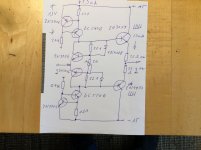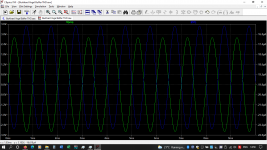Hi Joachim,
I think most of us stick to Lipshitz these days. I use the modified one for the HF EQ addition.
-Chris
I think most of us stick to Lipshitz these days. I use the modified one for the HF EQ addition.
-Chris
Joachim, horizontal axis is source resistance, not frequencyThis is the 2SK170. The noise goes up to lower frequencies.
I designed that Titanium speaker, yes. It was debree from a project for Audioquest to make something like the Tivoli radio. Martina found it in the thick bay. And so it goes.
I love them and I don't love titanium speakers!
If you remember Joachim you told me about white and pink noise on the bridge at Blenheim Palace. Interestingly the EF86 can be your ideal device or sound just like a bad bipolar type when made by another company ( not partition noise ). EF86 in pentode if JFET if the next stage is interesting. The EF86 must see >3 M ohms. For small signals a pentode can work. EF86 was a good triode also.
Analog dither is a well liked idea when class B to AB. It makes it faster ? CAS4040 mk1 ran in pure B. It sounded OK. MkII in AB. The AB was richer. The B was far from being awful.
Solid State Logic was two miles from my house. John who worked there told me they knew this. If you ever meet Dave Mate the designer you must get him to talk. He is hard work at first I think it is fair to say. Dave made a very special ampllifier based on a highly non linear output stage with very small gain differences uV to uV ( A chance for negative feedback to work said Dave ). I think he said like tube switching devices of old. A FETLINGTON is my guess. That's not an IGBT. this seems to be linked to undersatnding class B. John says it was a C-Audio amp modified as a prototype. I have no idea. I ran one for a while. SSL desks were too complex. The sound was OK really. SSL would teach people how to bypass circuits if they wanted it. 90 opamps in series ( NE5534/32 ). PSU stability was a factor.
Solid State Logic was two miles from my house. John who worked there told me they knew this. If you ever meet Dave Mate the designer you must get him to talk. He is hard work at first I think it is fair to say. Dave made a very special ampllifier based on a highly non linear output stage with very small gain differences uV to uV ( A chance for negative feedback to work said Dave ). I think he said like tube switching devices of old. A FETLINGTON is my guess. That's not an IGBT. this seems to be linked to undersatnding class B. John says it was a C-Audio amp modified as a prototype. I have no idea. I ran one for a while. SSL desks were too complex. The sound was OK really. SSL would teach people how to bypass circuits if they wanted it. 90 opamps in series ( NE5534/32 ). PSU stability was a factor.
Noise can be for electronics what a catalysator is for chemistry.
... and the end result can be (near) noise free while the (internal) process-noise is still there (catalyzing the process).
... and the end result can be (near) noise free while the (internal) process-noise is still there (catalyzing the process).
Last edited:
My favourite Dave Mate quotes " Nigel, you are in great danger of that working "
" I said ......... What do I know I am only the engineer ". This was when discussing ProTools I think which he was told were an amature thing.
" I said ......... What do I know I am only the engineer ". This was when discussing ProTools I think which he was told were an amature thing.
Buffer
I never promised you a rose garden but I promised to publish all buffer circuits I can find that are interesting enough just for completeness.
This one is from the new Burkhard Vogel book “ Balanced Phonostages “.
In the old days I would have called that an Allison Buffer because the signal goes into the emitters and not the bases. I would be fine if we could calculate the input impedance.
I never promised you a rose garden but I promised to publish all buffer circuits I can find that are interesting enough just for completeness.
This one is from the new Burkhard Vogel book “ Balanced Phonostages “.
In the old days I would have called that an Allison Buffer because the signal goes into the emitters and not the bases. I would be fine if we could calculate the input impedance.
Attachments
I ran a ribbon microphone like that. Great sound and found all the under street cables in Oxford. It was a Reslo.
BC 337/327 could work.
BC 337/327 could work.
NotInput impedance is determined by the two current sources in parallel, not ?
Patrick
I fail to see beta in the in the model, but the result in post 11293
seems to reflect the simple proportionality Zin ∼ β*RL of a single
stage emitter follower, as expected.
seems to reflect the simple proportionality Zin ∼ β*RL of a single
stage emitter follower, as expected.
Buffer
Here is another buffer that I find kind of interesting. It is from the book Wideband Amplifiers.
Here the currents of the input transistors are mirrored into the output stage.
The author claims less idle and less distortion.
Here is another buffer that I find kind of interesting. It is from the book Wideband Amplifiers.
Here the currents of the input transistors are mirrored into the output stage.
The author claims less idle and less distortion.



